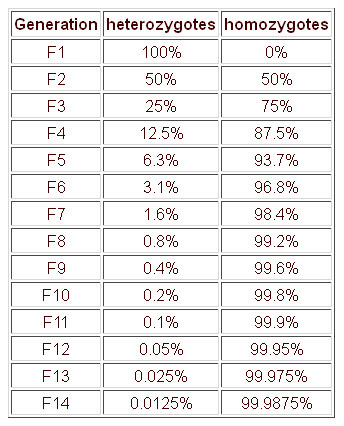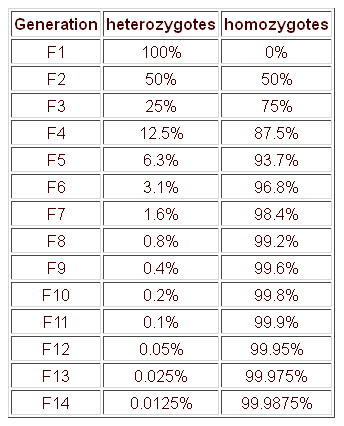I know I ran across something on a forum somewhere within this realm, where there was a genetic % of results for each year of grow-out for a cross. It was a hand-written note deal but split out the percentages of what you would expect year after year over eight years to bring a cross to stability. I didn't save or mark it, and I can't seem to find it. Some of the plants I have came from sources with undisclosed origins, but I have clear variations in pepper morphology in one particular "red bhut" All my others are thin skinned, pimply, pointy, and hot. This one plant is smooth-skinned, blunt-nosed, and seems to ripen differently (Orange first, then red?). The others go to a deeper orange-red and then deep red. I think I will be isolating this and growing out the successive seeds, to see what we come up with, but I suspect this plant was crossed with something before going to market.
-
Do you need help identifying a 🌶️?
Is your plant suffering from an unknown issue? 🤧
Then ask in Identification and Diagnosis. -
✅ Expert and friendly hot pepper grow advice.
✅ The latest information on hot pepper varieties.
✅ Reliable seed trading.
✅ Hot sauce recipes and food safety guidance.
✅ Hot sauce business tips for startups.
🌶️ And more!
It's all here, at The Hot Pepper! The Internet's original hot pepper community! Est. 2004.
You are using an out of date browser. It may not display this or other websites correctly.
You should upgrade or use an alternative browser.
You should upgrade or use an alternative browser.
breeding-crossing Crossing Peppers and the genetics of getting to "stabilization"
- Thread starter Chorizo857_62J
- Start date
Chorizo857_62J said:It was a hand-written note deal but split out the percentages of what you would expect year after year over eight years to bring a cross to stability. I didn't save or mark it, and I can't seem to find it.
Is this what you are looking for?

That is close, and thanks. It was a listing of ratios for primary plant, cross, and recessive seed plant. First stage was I think a 1:6:1 ratio, and then got more complicated after that. Maybe I am over-thinking this, and that chart will suffice, as long as I get somewhere near an end. The real thing I want to see is if the offspring of this "not" a bhut pepper reveal something wildly different. As with the picture, it is not like the red bhuts that I acquired, all at the same time. Thus it may be a cross and I am somewhere in the middle of the process. Hence growing seeds out for a season or two? Who loves a good mystery?
Thanks for chiming in!
Thanks for chiming in!
Chorizo857_62J said:I know I ran across something on a forum somewhere within this realm, where there was a genetic % of results for each year of grow-out for a cross. It was a hand-written note deal but split out the percentages of what you would expect year after year over eight years to bring a cross to stability.
I remember that post a thinking it was the same as what I've used in the past, see pic at bottom of my post. It comes from this article,Tomato Gene Basics,which elaborates on "crossing".

Edit: OOOPPPSSS! Late to the party!
I'm not sure I understand your exact question, but it sound like you are talking about the punnet squares/distributions for mono-hybrid crosses. F1, the pods you have, are 100% D/R. Your seeds in the pods will be F2, so you will see 25% each DD DR RD RR. The visible RR will be homozygotic as to the R phenotype, and as to the D phenotype your selected seeds will be 1/3 DD (homozygotic) and 2/3 heterozygotic (50% DR and 50% RD) but visually indistinguishable. As you select each generation you discard the RR (if you're selecting for DD) and the % of DD (homozygotic) will increase according to BF's chart right column, thus the likelihood of heterozygosity (DR or RD) diminishes as per the left column.
Not all crosses/traits are mono-hybrid crosses however. If multiple alleles are involved (such as a dihybrid or trihybrid crosses) the distributions will vary accordingly.
EDIT - NECM snuck one in on me - nice one! That's a great article with solid basics.
Also consider this regarding distributions - http://www.science.oregonstate.edu/genbio/otherresources/punnett%20squares.htm
Not all crosses/traits are mono-hybrid crosses however. If multiple alleles are involved (such as a dihybrid or trihybrid crosses) the distributions will vary accordingly.
EDIT - NECM snuck one in on me - nice one! That's a great article with solid basics.
Also consider this regarding distributions - http://www.science.oregonstate.edu/genbio/otherresources/punnett%20squares.htm
Also remember that these are mathematical odds. Doesn't mean that will happen in real life. Also, if you save seed for 10 generations from a single plant each generation, and the plant you select is heterozygous in each generation (it can happen) then you still won't have a stabilized variety.
You might like to read this book, to help understand what it takes to breed and stabilize a new plant variety : Breed Your Own Vegetable Varieties: The Gardener’s and Farmer’s Guide to Plant Breeding and Seed Saving, 2nd Edition by Carol Deppe.
You might like to read this book, to help understand what it takes to breed and stabilize a new plant variety : Breed Your Own Vegetable Varieties: The Gardener’s and Farmer’s Guide to Plant Breeding and Seed Saving, 2nd Edition by Carol Deppe.
Thanks All.
Is this the handwritten / hand drawn picture you were referring to?

That paper contains some good info, but it also has a fundamental issue. The "50% looks like a new phenotype" part is not right. The 25% / 50% / 25% distribution results from a monohybrid cross, which will yield only 2 phenotypes at an appearance ratio of 75% D, 25% R.
If you're seeing a third phenotype, then either:
1. the parents weren't homozygotic
2. there was a mistake made in the breeding, or
3. it is not a monohybrid cross, meaning more than 1 "gene" controls the desired traits.
In the "not a monohybrid" case, which is very common, distribution is not 25/50/25 (4 different gene combinations (DD, DR, RD, RR) with a 3:1 visible difference ratio), but at a minimum 16 different gene combinations with a 9:3:3:1 visible difference ratio).
Bottom line, if something funky happens it's almost certainly one of the three things above and they come into play all the time. People grow too few plants and often think they are playing in the "mono" space, when they really aren't.
If you're seeing a third phenotype, then either:
1. the parents weren't homozygotic
2. there was a mistake made in the breeding, or
3. it is not a monohybrid cross, meaning more than 1 "gene" controls the desired traits.
In the "not a monohybrid" case, which is very common, distribution is not 25/50/25 (4 different gene combinations (DD, DR, RD, RR) with a 3:1 visible difference ratio), but at a minimum 16 different gene combinations with a 9:3:3:1 visible difference ratio).
Bottom line, if something funky happens it's almost certainly one of the three things above and they come into play all the time. People grow too few plants and often think they are playing in the "mono" space, when they really aren't.
That was the paper I was looking for, thanks. will still take into consideration all of you welcomed input. Thanks Again!

